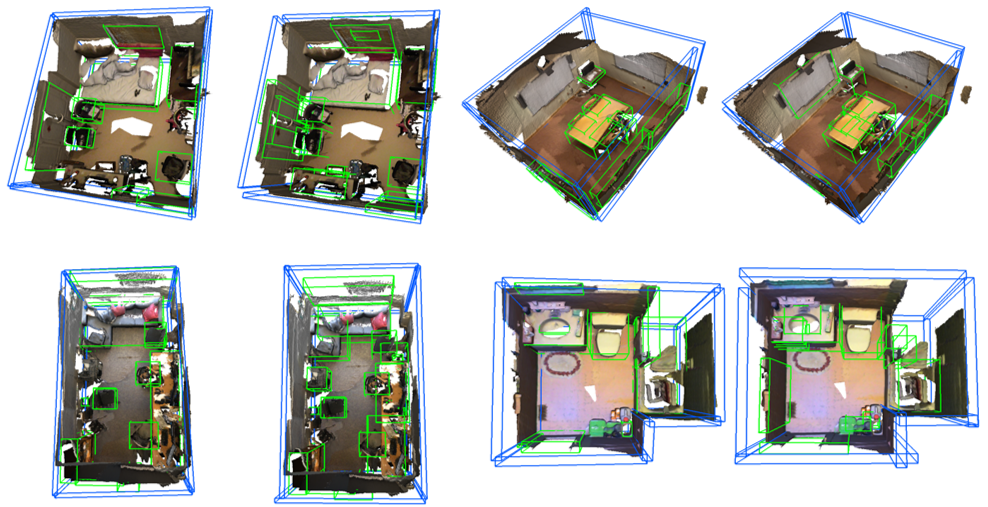Accepted to RA-L & ICRA 2022.
Created by Xiaoxue Chen, Hao Zhao, Guyue Zhou and Ya-Qin Zhang from Institute for AI Industry Research(AIR), Tsinghua University.
3D scene understanding from point clouds plays a vital role for various robotic applications. Unfortunately, current state-of-the-art methods use separate neural networks for different tasks like object detection or room layout estimation. Such a scheme has two limitations: (1) Storing and running several networks for different tasks are expensive for typical robotic platforms. (2) The intrinsic structure of separate outputs are ignored and potentially violated.
In this repository, we propose the first transformer architecture that predicts 3D objects and layouts simultaneously, using point cloud inputs. Unlike existing methods that either estimate layout keypoints or edges, we directly parameterize room layout as a set of quads. As such, the proposed architecture is termed as P(oint)Q(uad)-Transformer. Along with the novel quad representation, we propose a tailored physical constraint loss function that discourages object-layout interference. The quantitative and qualitative evaluations on the public benchmark ScanNet show that the proposed PQ-Transformer succeeds to jointly parse 3D objects and layouts, running at a quasi-real-time (8.91 FPS) rate without efficiency-oriented optimization. Moreover, the new physical constraint loss can improve strong baselines, and the F1-score of the room layout is significantly promoted from 37.9% to 57.9%. Code and models will be made publicly available.
If you find our work useful in your research, please consider citing:
@article{chen2022pq,
title={Pq-transformer: Jointly parsing 3d objects and layouts from point clouds},
author={Chen, Xiaoxue and Zhao, Hao and Zhou, Guyue and Zhang, Ya-Qin},
journal={IEEE Robotics and Automation Letters},
year={2022},
publisher={IEEE}
}
python =3.6
CUDA>=10.1
Pytorch>=1.3
matplotlib
opencv-python
tensorboard
termcolor
plyfile
trimesh>=2.35.39
networkx>=2.2
scripy
Compile the CUDA layers for PointNet++:
cd pointnet2
python setup.py install
For 3D detection on ScanNet, follow the README under the scannet folder.
For layout estimation on ScanNet, download the sceneCAD layout dataset from
HERE. Unzip it into /path/to/project/scannet/.
You can download pre-trained model HERE.
Move the file to the project root path (/path/to/project/pretrained_model) and then run:
CUDA_VISIBLE_DEVICES=0 python -m torch.distributed.launch --nproc_per_node 1 eval.py --checkpoint_path /path/to/project/pretrained_model/ckpt_epoch_last.pth
The demo uses the pre-trained model to jointly detect objects and layouts from point cloud of an indoor scene. You can get dump visualized results with:
CUDA_VISIBLE_DEVICES=0 python -m torch.distributed.launch --nproc_per_node 1 eval.py --checkpoint_path /path/to/project/pretrained_model/ckpt_epoch_last.pth --dump
And then you can use 3D visualization software such as the MeshLab to open the .ply files under /path/to/project/demo/ to see the 3D detection output.
To train a PQ-Transformer model on Scannet with a single GPU:
CUDA_VISIBLE_DEVICES=0 python -m torch.distributed.launch --nproc_per_node 1 train.py --log_dir log/[log_dir] --pc_loss
You can change the learning rate, number of proposals or other parameters with arguments shown in train.py.
To test the trained model with its checkpoint:
CUDA_VISIBLE_DEVICES=0 python -m torch.distributed.launch --nproc_per_node 1 eval.py --log_dir [log_dir] --checkpoint_path [checkpoint_path]
We want to thank codebase of VoteNet and Group-Free. And also thanks to dataset ScanNet and layout annotation from SceneCAD.
